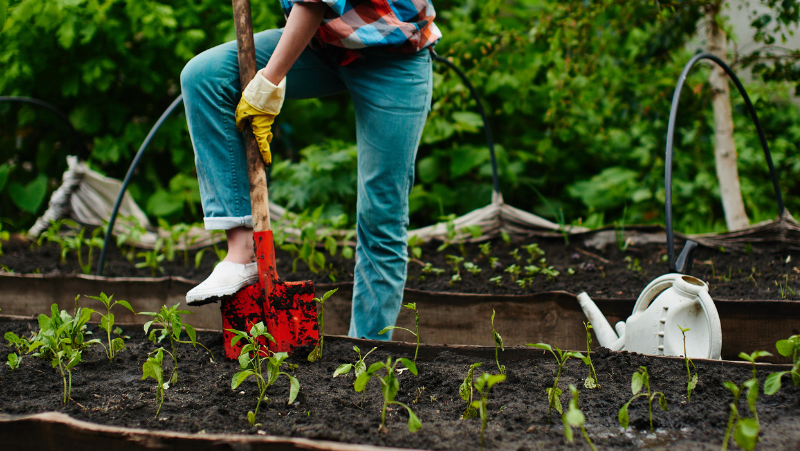Yates Account
Join now
Create a Yates account today!
Sign up to join the Yates Garden Club for monthly e-mails packed with seasonal inspiration, tips for success & exclusive promotions.
Plus if you’re a Garden Club member you can take part in the Yates Growing Community - a blog to share successes, get advice & win prizes in fun challenges along the way!

Forgot password
Enter the email address associated with your account, and we'll email you a new password.

- Soil is a complex blend of organic matter, minerals, water, air, and microorganisms.
- Many of today's antibiotics have been derived from soil - eg. penicillin.
- Soil is made up - clay, sand and loam. They are grouped according to the amounts of coarse sand and fine clay particles and organic matter they contain.
- A teaspoon of healthy soil can contain up to a billion bacteria.
- In only 1g of soil, there can be hundreds of metres of fungal hyphae (strands of fungal growth).
- A healthy population of soil microbes can help reduce pathogens that cause plant diseases.
- Atmospheric carbon dioxide can be stored ('sequestered') in soil.
- Productive soil can contain up to 7 million earthworms per hectare.
- The giant North Auckland earthworm (Spenceriella gigantea) can be up to 1.5m metres long!
- Yes, earthworms do have a front and back end! They have a mouth at the head end and a bum at the other end.
- Earthworms can eat up to a third of their body weight every day.
- Soil rich in organic matter can store up to 30% of its weight in water.
- Clinical studies have revealed daily gardening can reduce the risk of dementia by 36%.
- Soil contains more than 25% of our planet's biodiversity.
- It is thought that early exposure to microorganisms, including soil microorganisms, could help reduce disease incidence later in life.
- Soil is able to filter and trap environmental pollutants, helping to prevent them from leaching into the groundwater.
- There are around 6000 species of earthworms in the world.
- Soil contains microorganisms that may promote happiness in humans.
- What is clay? Clay is very small mineral particles of weathered rocks and clay soil can retain lots of moisture and nutrients. Clay soil can be improved by adding organic matter, like Yates Dynamic Lifter Organic Plant Food.
- What is sand? Sand is coarse, loose particles of rocks and minerals. Sandy soil drains freely and doesn't hold nutrients well. Sandy soil can be improved by adding organic matter, like Yates Dynamic Lifter Organic Plant Food.
- What is loam? Loam soil is a wonderful mixture of clay and sand particles plus organic matter.
- Soil is home to a quarter of the earth's organisms!
- Soil microorganisms are very important - they break down organic matter into nutrients that plants can use.
- Organic matter in the soil can store water like a sponge. You can help increase your soil's organic matter levels by regularly applying Yates Dynamic Lifter Organic Plant Food.
- What is soil pH? It's a measure of soil acidity or alkalinity. Most plants like growing in soil that's close to pH 'neutral' or just slightly acidic (pH 6.5-7). You can measure your soil pH with a store-bought soil pH test kit.
- Earthworms breathe through their skin.
- There are special soil bacteria that live on the roots of legumes, like peas and beans, that convert nitrogen in the air into nitrogen that plants can use.
- Plant roots need access to oxygen. Burrowing earthworms help aerate the soil, allowing more air (and oxygen) to plant roots.
- How do you encourage more earthworms and soil microorganisms? They both love organic matter, so regular applications of Yates Dynamic Lifter Organic Plant Food will promote more of these wonderful soil inhabitants.
- It's vital that we care for our soils. Around 95% of the world's food is produced on soil!
More project guides & articles
Roots & shoots for winter planting
Sustainable Gardening
Vegetable Companion Planting
Top 10 herbs
References
http://www.soils4kids.org/about
https://www.ncbi.nlm.nih.gov/pmc/articles/PMC2731226/
http://forces.si.edu/soils/04_00_01.html
https://www.sciencedaily.com/releases/2016/12/161214085741.htm
http://www.sciencedirect.com/science/article/pii/S0038071714003678
http://www.nature.com/scitable/knowledge/library/soil-carbon-storage-84223790
http://www.dpi.nsw.gov.au/land-and-water/soils/biology/earthworms
https://en.wikipedia.org/wiki/Giant_Gippsland_earthworm
http://www.biokids.umich.edu/critters/Oligochaeta/
http://www.nationalgeographic.com/animals/invertebrates/c/common-earthworm/
http://www.agvise.com/educational-articles/water-holding-capacity/
http://therapeuticgardens.com.au/sensory-gardens-for-individuals-with-dementia/
http://www.fao.org/soils-2015/resources/information-material/en/
http://www.the-scientist.com/?articles.view/articleNo/31879/title/Let-Them-Eat-Dirt/
http://www.fao.org/soils-2015/resources/information-material/en/
https://australianmuseum.net.au/australian-earthworms
http://www.bristol.ac.uk/news/2007/5384.html
http://www.fao.org/fileadmin/user_upload/soils-2015/images/EN/WSDPosters_Promotional_Material/En_IYS_food_Print.pdf
https://australianmuseum.net.au/australian-earthworms
http://www.soilhealth.com/soil-health/biology/beneficial/rhizobia/index.htm
http://www.fao.org/soils-2015/resources/information-material/en/













Share
Share this article on social media